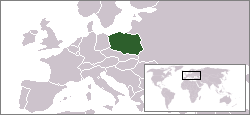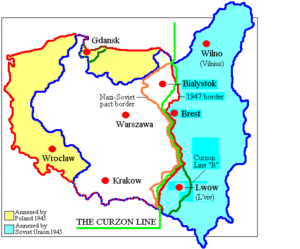People's Republic of Poland
|
|
The People's Republic of Poland or Polish People's Republic (Polish: Polska Rzeczpospolita Ludowa, PRL) was the official name of Poland from 1952 to 1989, during its period of rule by the Communist party, officially called the Polish United Workers' Party (Polska Zjednoczona Partia Robotnicza, or PZPR). The Communists were in effective control of the Polish government from 1944 onwards, but the new name was not adopted until the 1952 constitution came into effect.
| |||||
| National motto: none | |||||

| |||||
| Official language | Polish | ||||
|---|---|---|---|---|---|
| Capital | Warsaw | ||||
| Largest city | Warsaw | ||||
| Area - Total - % water | 312,685 km˛ 2.6% | ||||
| Currency | Złoty (PLN) | ||||
| Time zone | UTC +1 | ||||
| National anthem | Mazurek Dąbrowskiego | ||||
| Calling code | 48 | ||||
| Contents |
History
Main article: History of Poland (1945-1989)
At the Yalta Conference in February 1945, Stalin was able to present his western allies, Franklin Roosevelt and Winston Churchill, with a fait accompli in Poland. His armed forces were in occupation of the country, and his agents, the Polish Communists, were in control of its administration. The USSR was in the process of incorporating the lands in eastern Poland which it had occupied between 1939 and 1941. In compensation, the USSR awarded Poland all the German territories in Pomerania, Silesia and Brandenburg east of the Oder-Neisse Line, plus the southern half of East Prussia. Stalin was determined that Poland's new government would be controlled by the Communists. He had severed relations with the Polish government-in-exile in London in 1943, but to appease Roosevelt and Churchill he agreed at Yalta that a coalition government would be formed. The Communists held a majority of key posts in this new government, and with the Soviet support they soon gained almost total control of the country, rigging all elections. Their opponents, led by Stanisław Mikołajczyk, managed only one but substantial victory: Poland preserved its status as an semi-independent state, contrary to the plans of some influential communists such as Wanda Wasilewska, who were in favour of Poland becoming another republic of the Soviet Union. This important victory would be their last, however, as Communists tightening their grip on power began political persecution of all opposition. Many of their opponents decided to leave the country, others were put on staged trials and sentenced to many years of imprisonment or execution.
In 1948 the Communists consolidated their power, forming the Polish United Workers' Party (known in Poland as 'the Party'), which would monopolise the political power in Poland until 1989. Over the coming years, private industry was nationalised, the land seized from the prewar landowners and redistributed to the peasants, and millions of Poles transferred from the lost eastern territories to the lands acquired from Germany. After 1948 Poland was now to be brought into line with the Soviet model of a "people's democracy" and a centrally planned socialist economy. The regime also embarked on the collectivisation of agriculture, although the pace was slower than in other satellites: Poland remained the only Soviet bloc country where individual peasants dominated agriculture. Despite the fact that Polish historians estimate that 200,000 to 400,000 people died during the postwar period, Polish Stalinism was not quite as severe as it was in the other satellite states.
Ac.polishposter.jpg
In June 1956, workers in the industrial city of Poznań (Posen) went on strike. Voices began to be raised in the Party and among the intellectuals calling for wider reforms of the Stalinist system. Eventually power shifted towards Wladyslaw Gomulka, who replaced the Bolesław Bierut as the head of the government. Hardline Stalinists were removed from power and many Soviet officers serving in the Polish Army were dismissed. This marked the end of the 'Stalin Poland'. By the mid 1960s Poland was starting to experience economic as well as political difficulties. As Gomułka's popularity declined and his "reform Communism" lost its impetus, the regime became steadily less liberal and more repressive.
The next stage of Polish history began in December 1970, when Gomułka's government decided to prop the failing economy by suddenly announcing massive increases in the prices of basic foodstuffs. The resulting wide-spread protests led to another major change in the government, as Gomułka was replaced by Edward Gierek as the new First Secretary. Gierek's plan for recovery was centered on massive borrowing, mainly from the United States and West Germany, to re-equip and modernise Polish industry, and to import consumer goods to give the workers some incentive to work. While it has boosted the Polish economy, and is still remembered as the Golden Age of Communist Poland, the obvious repercussion in the form of massive debt is still felt in Poland even today. This Golden Age came to an end after the 1973 energy crisis. Soon the failure of the Gierek regime, both economically and politically, led to the creation of opposition, in the form of trade unions, student groups, clandestine newspapers and publishers, imported books and newspapers, even a "flying university."
Kolejka.jpeg
At this juncture, on 16 October 1978, Poland experienced what many Poles believed to be literally a miracle. The Archbishop of Kraków, Karol Wojtyła, was elected Pope, taking the name John Paul II. The election of a Polish Pope had an electrifying effect on what was by 1970 notably one of the most devoutly Catholic nations in Europe. When John Paul toured Poland in June 1979, half a million people heard him speak in Warsaw, and about a quarter of the entire population of the country attended at least one of his outdoor masses. Overnight, John Paul became the de facto leader of Poland, leaving the regime not so much opposed as ignored. John Paul did not call for rebellion, instead he encouraged the creation of an "alternative Poland" of social institutions independent of the government, so that when the next crisis came, the nation would present a united front.
A new wave of strikes undermined Gierek's government and in September Gierek, who was in poor health, was finally removed from office and replaced as Party leader by Stanisław Kania. However Kania was unable to find an answer for the fast-eroding support of the communism in Poland. Labour turmoil in 1980 led to the formation of the independent trade union, "Solidarity" (Polish Solidarność), founded in September 1980, originally led by Lech Wałęsa. In the 1980s, it gathered a broad anti-communist social movement ranging from people associated with the Roman Catholic Church down to members of the anti-communist left. By the end of 1981, Solidarity had nine million members, a quarter of Poland's population and three times as much as the PUWP had.
Jaruzelski_przemowienie.jpg
On December 13, 1981, the government leader Wojciech Jaruzelski who became the party's national secretary and prime minister that year, fearful of Soviet intervention started a crack-down on Solidarity, declaring a martial law in Poland, suspending the union, and temporarily imprisoning most of its leaders. The government then banned Solidarity on October 8, 1982. Martial Law was formally lifted in July, 1983, though many heightened controls on civil liberties and political life, as well as food rationing, remained in place through the mid- to late 1980s.
This did not prevent "Solidarity" from gaining more support and power, and it eventually eroded the dominance of the Communist Party, which in 1981 lost ca. 85,000 of its 3 million members. Throughout the mid-1980s, Solidarity persisted solely as an underground organization. But by the late 1980s, Solidarity was sufficiently strong to frustrate Jaruzelski's attempts at reform, and nationwide strikes in 1988 were one of the factors that forced the government to open a dialogue with Solidarity.Okragly_Stol_1989.jpg
Government and politics
PZPR.png
The government and politics of the People's Republic of Poland were dominated by the Polish United Workers' Party (Polska Zjednoczona Partia Robotnicza, PZPR). In effect, Poland was a single-party state following a communist ideology, dependent on the USSR to the extent of being its puppet state.
Economy
Main article: Economy of Poland
Culture
Main article: Culture of Poland
Main article: Education in the People's Republic of Poland
Geography and demographics
Main article: Voivodships of Poland
Poland borders shifted drastically after the Second World War.
People's Republic of Poland was divided into several voivodships (Polish unit of administrative division). After the World War II the new administrative division was based on pre-war one. The areas in the East that were not annexed by the Soviet Union had their borders left almost unchanged. Newly acquired territories in the west and north were organised into the voivodships of Szczecin, Wrocław, Olsztyn and partially joined to Gdańsk, Katowice and Poznań voivodships. Two cities were granted voivodship status: Warsaw and Łódź.
In 1950 new voivodships were created: Koszalin - previously part of Szczecin, Opole - previously part of Katowice, and Zielona Góra - previously part of Poznań, Wrocław and Szczecin voivodships. In addition, three other cities were granted the voivodship status: Wrocław, Kraków and Poznań.
In 1973 Poland voivodships were changed again. This reorganization of administrative division of Poland was mainly a result of local government reform acts of 1973-1975. In place of three level administrative division (voivodship, county, commune), new two-level administrative division was introduced (49 small voidships and communes). The three smallest voivodships: Warsaw, Cracow and Lodz had a special status of municipal voivodship; the city president (mayor) was also province governor.





